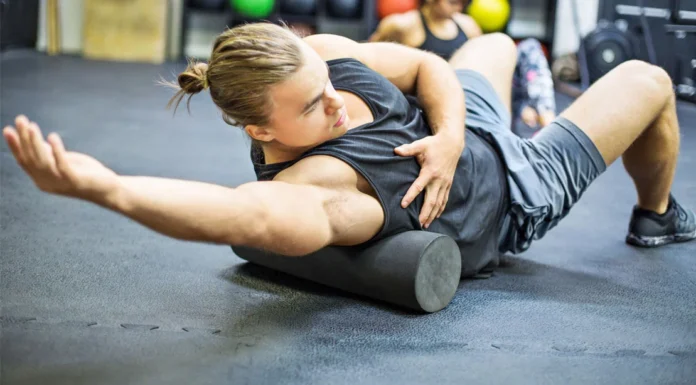Remember how back in your teens and early 20s, you never had to worry about silly things like muscle aches or throwing your back out doing what seemed like a simple everyday task?
That time is out the window as soon as most people hit their mid-30s and older. Things start to run a little tighter as we age. Even routine tasks like working under the sink on pipe clogs or bending down to pick up a box too quickly at an odd angle can lead to muscle, backache, or neck pain. While these “accidents” as we age are not life-threatening, they undoubtedly create problems that just weren’t on our radar in our spry years.
When it happens – and we say “when,” not “if,” because it is inevitable for most people – there are several things you can do to shorten your recovery time. Moreover, the same tips for healthy back and neck muscles can be used daily to help prevent injury in the future.
Yoga and Stretching

You probably hear this all the time when discussing your aches and pains with work colleagues, friends, and family, but stretching really does help!
According to a Harvard Medical School report, you are more likely to experience pain due to weak back and abdominal muscles. A regular stretching regimen helps to relieve that pain, but perhaps more importantly, it helps to prevent a recurrence of the problem because stretching keeps your body in proper alignment.
There are scores of guided videos available online to help you get started. You’ll want to begin healing that pulled muscle as soon as the pain hits. It will be uncomfortable and may hurt a bit. But you will start feeling better in less time if you lightly stretch one to three times daily while injured.
Don’t forget you’ve got more than just your back muscles! Focus on the area where pain presents, but also remember that all the muscles in your body are connected front to back, top to bottom, and side to side. So, multiple stretches over 15 – 30 minutes are highly recommended.
If your back injury is fresh, consider starting slow with core yoga stretches on the floor. Try bringing one knee to the chest at a time, pulling both knees to the chest, and the wide child’s pose. These low-impact exercises stretch the muscles across your entire back, buttocks, and hamstrings — all common areas that become tight and can lead to injury. They are great starting exercises because they can be done even if you feel like the pain generally immobilizes you. Do these stretches every few hours and hold the poses so long as they are comfortable. It may hurt when first getting into the pose, but within a few minutes, you will start to feel pain relief.
Once the injury begins to heal, you can move on to more advanced poses like the half lotus twist, the cow, and the standing back bend.
Doing these six exercises several times daily will make you feel better and shortens your recovery time.
Foam Rolling

Foam rolling is a great way to engage in what you may refer to as self-administered massage. Don’t wait until you throw out your back to purchase a foam roller, either. Foam rollers are the gift to yourself that keeps on giving, so buy one ahead of time and use it daily as a preventative for muscle aches.
Should you throw out your back, you can combine your yoga stretching with foam rolling in the same session.
Personal trainers and physical therapists recommend starting with foam rolling before stretching, but the order is up to you since we’re using low-impact stretches and rolling.
To use one, you’ll want to lay directly on the foam roller, and your weight will apply the pressure to target pain areas. You can lay directly on it for coverage across your entire upper back. For lower back pain and injuries, lay on only one side of the foam roller at a time. You should never foam roll vertebrae, joints, or boney areas of the body. Once you’ve found your foam rolling position, you’ll very slowly move across the roller, massaging across the muscle – even in areas where there is no pain.
This deep massage will relax muscle tissue, especially if it is tight, and relieve pain.
Natural Pain Relief Supplementation

In addition to direct physical targeting of muscle pain with stretching and foam rolling, you can also try natural medicine that targets the central nervous system’s biological receptors to help dull the pain during your recovery period.
Clinical research into hemp-based extracts like cannabidiol (CBD) suggests that taking it orally or sublingually in the form of a broad spectrum CBD oil may provide rapid relief.
In a clinical study involving several hundred patients with pain related to the back, neck, and migraines, 60% of those taking CBD reported that it helped them to reduce their pain. Another 20% said that their pain was relieved entirely following CBD administration.
A single dose of CBD peaks at about 6 – 8 hours after taking it, with dosages ranging between 50 and 400 milligrams of CBD per day.
Daily Preventative Maintenance
Our muscles, tendons, ligaments, and bones become more brittle as we age. But that doesn’t have to stop us from living a healthy, active lifestyle.
The tips above will help following a back muscle injury, but what if you can prevent such a painful recurrence in the future?
Doctors, physical therapists, and personal trainers recommend exercising daily for at least half an hour. This could include aerobics and light weightlifting but stretching and foam rolling are also very effective in helping to maintain optimal health. As your body gets used to exercising and working out regularly, you can also increase the intensity, pace, and complexity of the stretches you are engaging in.
Yoga, for example, has hundreds of poses and styles that can be implemented as you advance your daily regimen.
Coupled with supplementation using natural medicines like CBD that target pain and improve health from the inside out, a proper daily wellness plan can make all the difference.









